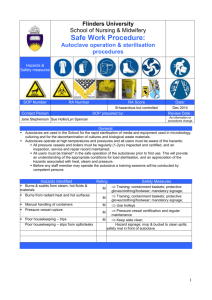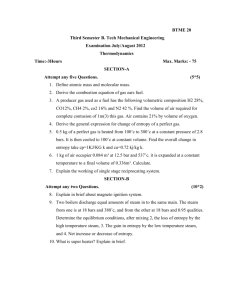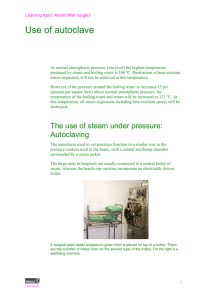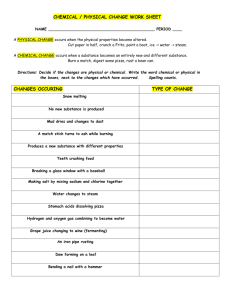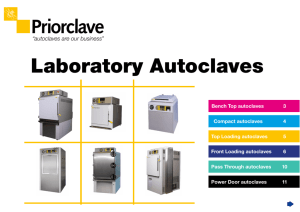Chapter - 9 : Common Laboratory Equipment
advertisement
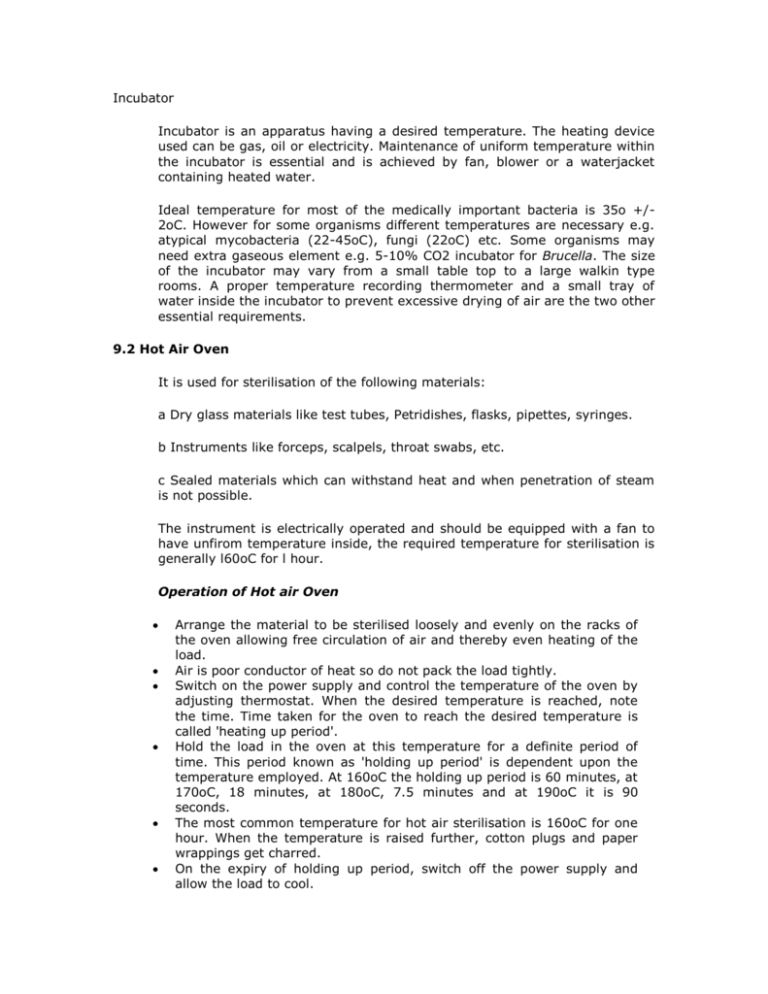
Incubator Incubator is an apparatus having a desired temperature. The heating device used can be gas, oil or electricity. Maintenance of uniform temperature within the incubator is essential and is achieved by fan, blower or a waterjacket containing heated water. Ideal temperature for most of the medically important bacteria is 35o +/2oC. However for some organisms different temperatures are necessary e.g. atypical mycobacteria (22-45oC), fungi (22oC) etc. Some organisms may need extra gaseous element e.g. 5-10% CO2 incubator for Brucella. The size of the incubator may vary from a small table top to a large walkin type rooms. A proper temperature recording thermometer and a small tray of water inside the incubator to prevent excessive drying of air are the two other essential requirements. 9.2 Hot Air Oven It is used for sterilisation of the following materials: a Dry glass materials like test tubes, Petridishes, flasks, pipettes, syringes. b Instruments like forceps, scalpels, throat swabs, etc. c Sealed materials which can withstand heat and when penetration of steam is not possible. The instrument is electrically operated and should be equipped with a fan to have unfirom temperature inside, the required temperature for sterilisation is generally l60oC for l hour. Operation of Hot air Oven Arrange the material to be sterilised loosely and evenly on the racks of the oven allowing free circulation of air and thereby even heating of the load. Air is poor conductor of heat so do not pack the load tightly. Switch on the power supply and control the temperature of the oven by adjusting thermostat. When the desired temperature is reached, note the time. Time taken for the oven to reach the desired temperature is called 'heating up period'. Hold the load in the oven at this temperature for a definite period of time. This period known as 'holding up period' is dependent upon the temperature employed. At 160oC the holding up period is 60 minutes, at 170oC, 18 minutes, at 180oC, 7.5 minutes and at 190oC it is 90 seconds. The most common temperature for hot air sterilisation is 160oC for one hour. When the temperature is raised further, cotton plugs and paper wrappings get charred. On the expiry of holding up period, switch off the power supply and allow the load to cool. Open the oven door only when the temperature fall below 80oC, otherwise it may result in breaking up of glassware and also cause injuries to the operator. Dry up the instruments before placing them in the hot air oven. Do not place the heat sensitive materials inside. 9.3 Water Bath: Water bath is a water container having an electrically operated heating device to provide a fixed and uniform temperature. A thermometer is inserted inside the water bath for recording temperature. A mixer immersed inside water is also desired to maintain uniform temperature throughout the water bath. A few applications of water bath are: 37oC Water bath - required during performance of WIDAL test; 44oC Water bath - required in faecal coliform count (water bacteriology) test. 56oC Water bath - for inactivating complement in the serum. 9.4 Centrifuge For an average laboratory a small table top centrifuge with a maximum revolutions per minute of 6000 and capable of accommodating l0-12 tubes of l5 ml capacity is sufficient. The tubes should be placed exactly opposite to each other, should be of the same weight and should contain same amount of fluid. The speed is adjusted by a rheostat and should be allowed to rise slowly. A timer for fixed duration of centrifugation is preferred. A few common uses are: Sediment examination of urine - 1500 rpm for 5 minutes. Separation of serum from clotted blood - 1500 rpm for l5 minutes. Concentration of microfilaria from blood - 2000 rpm for 2-5 minutes. 9.5 pH METER A pH meter consists of an electrode pair which is sensitive to hydrogen ion concentration due to the development of an electrical gradient which is directly proportional to the hydrogen ion concentration. The electrodes commonly used are one of glass for the unknown and other of colomel to be used as a standard precautions while using pH meter are: The electrodes specially the glass ones should be handled carefully to prevent breakage due to contact with hard surface. Sufficient time should be given to warm up the instrument before use. Frequent standardizations of the pH meter should be made using standard buffer solution. Electrodes are to be washed with a stream of distilled water between measurements. The electrodes should never be removed from the solution when the measuring circuit is closed. When not in use, the electrodes must be kept immersed in water or electrode solution. 9.6 Refrigerator: Refrigferators are essential for storage of degradable laboratory substances like media, reagents, antisera, antibiotic discs etc. Refrigerators can vary in their capacity ranging from table top to a large walk-in-type. The usual temperature needed is 4o C +/- 2oC which is maintained comfortably by household use refrigerators. Substances to be kept at frozen state like sera may be kept in the freezer units of the same (-8oC). Proper recording of the temperature is very important to avoid deterioration of biological materials. 9.7 Microscope Place a slide on the stage, specimen side up and the centre of the section to be examined as accurately as possible over the hole in the centre of the stage. Adjust the mirror until it reflects the maximum amount of the light through the specimen with the low objective in position, lower the body tube by means of the coarse adjustment until the objective is about 1/4" from the slide. Look through the eye piece and slowly raise the objective with the coarse adjustment until the specimen is in approximate focus. Never focus downward while looking through the eye piece. Bring the specimen to sharp focus with the fine adjustment. Adjust the iris diaphgram and substage. Condense until the light intensity is optimum. After examining the specimen with the low power objective shift to the high dry objective by rotating the nose piece until the objective clicks into place. Look through the eye piece and slowly raise the body tube with the coarse adjustment until the specimen comes into approximate focus. Then bring the image into final accurate focus by using the fine adjustment. Once the specimen is in focus adjust the mirror and the iris diaphgram to give the clearest possible image. Focussing of the oil immersion objective:- First use the low power objective to locate the portion of the specimen to be examined. Raise carefully the body tube, and then rotate the nose piece until the oil immersion objective clicks into the position. Now place a drop of immersion oil on the portion of the slide directly under the objective watching the object from the side carefully lower it into the oil. Do not allowthe objective to touch the slide. Look through the occular and slowly focus upward with the fine adjustment until the immage appears. Once it appears do the fine adjustment and adjust the mirror and iris diaphragm to obtain optimum illumination. Maintenance Never touch the lenses if they become dirty, wipe them gently with lens paper/lint-free smooth cloth.. Always remove oil from the oil immersion objective after its use. If by accident, oil should get on either of the low power, wipe of the objective immediately with the lens paper. If oil becomes dry or hardened on a lens, remove it with lens paper lightly moistened with xylol. Keep the stage of the microscope clean and dry. Do not tilt the microscope when working with the oil immersion system. When the microscope is not in use, keep it covered in a microscope compartment. Never apply force to the microscope. Never allow the objective lenses to touch the cover glass or the slide. Never lower the body tube with the coarse adjustment while looking through the microscope. Never exchange the objective or occulars of different microscopes. Store the microscope in its cabinet when not in use. 9.8 Autoclave Principle Water boils when its vapour pressure equals the pressure of surrounding atmosphere. The temperature at sea level is 100oC. When water is boiled within a closed vessel at increased pressure, the boiling point of water is increased and so is the temperature of steam produced. This principle is employed in sterilising material by steam at temperature higher than 100oC and the process is called autoclaving. For autoclaving in the laboratory, the most agreeable and commonly used method is to use steam at 121oC for l5 to 30 minutes depending upon the particular material to be sterilised. Items to be sterilised: Autoclaving is most suitable for culture media, aqueous solutions, decontamination of discarded cultures and specimens, rubber items such as gloves, stoppers with rubber liner, glass ware with attached rubber tubings such as transfusion sets, glass metal syringes, etc. Autoclaves designed for laboratory work and capable of handling mixed loads should be used. 9.8.1 Types of autoclave Only autoclaves designed for laboratory work and capable of dealing with a 'mixed load' should be used. 'Porous load' and 'bottled fluid sterilizers' are rarely satisfactory for laboratory work. There are two varieties of laboratory autoclaves: Pressure cooker types; and Gravity displacement models with automatic air and condensate discharge. Pressure cooker type laboratory autoclaves: The most common type is a device for boiling water under pressure. It has a vertical metal chamber with a strong metal lid which can be fastened down and sealed with a rubber gasket. An air and steam discharge tap, pressure gauge and safety valve are fitted in the lid. Water in the bottom of the autoclave is heated by external gas burners, an electric immersion heater or a steam coil. Operating Instructions: There must be sufficient water inside the chamber. The autoclave is loaded and the lid is fastened down with the discharge tap open. The safety valve is then adjusted to the required temperature and the heat is turned on. When the water boils, the steam will issue from the discharge tap and carry the air from the chamber with it. The steam and air should be allowed to escape freely until all of the air has been removed. This may be tested by attaching one end of a length or rubber tubing to the discharge tap and inserting the other end into a bucket or similar large container of water. Steam condenses in the water and the air rises as bubbles to the surface; when all of the air has been removed from the chamber, bubbling in the bucket will cease. When this stage has been reached, the air-steam discharge tap is closed and the rubber tubing removed. The steam pressure then rises in the chamber until the desired rpessure, usually l5 lb/sq inch, is reached and steam issues from the safety valve. When the load has reached the required temperature the pressure is held for 15 min. At the end of the sterilizing period, the heater is turned off and the autoclave allowed to cool. The air and steam discahrge tap is opened very slowly after the pressure gauge has reached zero (atmospheric pressure). If the tap is opened too soon, while the autoclave is still under pressure, any fluid inside (liquid media, etc.) will boil explosively and bottles containing liquids may even burst. The contents are allowed to cool. Depending on the nature of the materials being sterilized, the cooling (or 'run-down') period needed may be several hours for large bottles of agar to cool to 80oC, when they are safe to handle. Autoclaves with air discharge by gravity displacement These autoclaves are usually arranged horizontally and are rectangular in shape, thus making the chamber more convenient for loading. A palette and trolley system can be used. The jacket surrounding the Gravity displacement autoclave consists of an outer wall enclosing a narrow space around the chamber, which is filled with steam under pressure to keep the chamber wall warm. The steam enters the jacket from the mains supply, which is at high pressure, through a valve that reduces this pressure to the working level. The working pressure is measured on a separate pressure gauge fitted to the jacket. This jacket also has a separate drain for air and condensate to pass through. The steam enters the chamber from the same source which supplies steam to the jacket. It is introduced in such a way that it is deflected upwards and fills the chamber from the top downwards, thus forcing the air and condensate to flow out of the drain at the base of the chamber by gravity displacement. The drain is fitted with strainers to prevent blockage by debris. The drain is usually fitted with a thermometer for registering the temperature of the issuing steam. The temperature recorded by the drain thermometer is often lower than that in the chamber. The difference should be found with thermocouple tests. A 'near to steam' trap is also fitted. The automatic steam trap or 'near-to-stream' trap is designed to ensure that only saturated steam is retained inside the chamber, and that air and condensate, which are at a lower temperature than saturated steam, are automatically discharged. It is called a 'near-to-steam' trap because it opens if the temperature falls to about 2oC below that of saturated steam and closes within 2oC or near to the saturated steam temperature. The trap operates by the expansion and contraction of a metal bellows , which open and close a valve. The drain discharges into a tundish in such a way that there is a complete airbreak between the drain and the dish. This ensures that no contaminated water can flow back from the waste-pipe into the chamber. Operation of a gravity displacement autoclave: If the autoclave is jacketed, the jacket must first be brought to the operating temperature. The chamber is loaded, the door is closed and the steam-valve is opened, allowing steam to enter the top of the chamber. Air and condensate flow out through the drain at the bottom. When the drain thermometer reaches the required temperature a further period must be allowed for the load to reach that temperature. This should be determined initially and periodically for each autoclave. Unless this is done the load is unlikely to be sterilized. The autoclave cycle is then continued for the holding time. When it is completed the steam valves are closed and the autoclave allowed to cool until the temperature dial reads less than 80oC. Not until then is the autoclave safe to open. It should first be 'cracked' or opened very slightly and left in that position for several minutes to allow steam to escape and the load to cool further.


